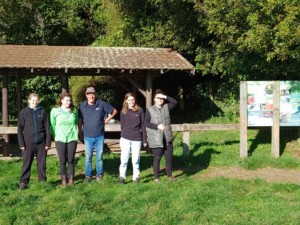
EIT | Te Pūkenga students (ākonga) use technology to find trap lines using GPS on their phones in Mohi Bush.
EIT | Te Pūkenga has teamed up with Hawke’s Bay Regional Council to give the Environmental diploma students (ākonga) an authentic learning experience while carrying out important predator control work in Mohi Bush.
Working with Hawke’s Bay Regional Council (HBRC), the ākonga took several trips to the bush area, setting ink cards in tracking tunnels, monitoring the predators presence and placing bait as part of rodent control to support re-introduced Toutouwai (the North Island Robin) and other native species.
Environmental Studies Lecturer Chris Thorman says it has been a “real authentic learning exercise with community benefits” for their ākonga studying the NZ Diploma in Environmental Management (Terrestrial strand) [Level 5].
“It’s a way of getting students involved in a real project, doing some conservation work, and learning about how to carry out predator control in a real-world environment.”
Chris says the majority of the class are keen to carry on and complete the Bachelor of Applied Science (Biodiversity Management) that is new to EIT | Te Pūkenga.
“This is definitely a growing employment area, and we are seeing significant interest in this programme. We have structured the programme so students can exit at any point with a diploma or go on to do the whole three-year degree, making it flexible and local,” Chris says.
Hawke’s Bay Regional Council Biodiversity Advisor Natalie de Burgh says the Regional Council were “really keen” to provide ongoing protection for the now significant and rare population of robins in the bush, after their original five-year Cape-to-City landscape scale project came to an end in June 2020.
The Cape-to-City project translocated robins from Boundary Stream Mainland Island to the Maraetōtara Plateau, which includes Mohi Bush, in 2017 in an effort to restore species lost through habitat modification and predation.

EIT | Te Pūkenga students (ākonga) Jordyn Campbell (left) Tiana Gillett, Holly Bennett and Emily Strong with Environmental Studies Lecturer Chris Thorman (middle).
“That’s why we started working with EIT | Te Pūkenga as we thought it would be a great project for students to help protect the robins and learn practical conservation skills in an awesome piece of bush,” says Ms Natalie de Burgh.
“We are really envisioning this as the first steps because there’s been an awful lot of research done in Mohi Bush as part of the Cape to City project. So potentially as the students move up through the course, they might want to do bird counts or look at invertebrates – there’s quite a lot of scope.”
On their first visit the students used technology to find trap lines using GPS on their phones and put out inked cards in tunnels so that as predators walked through, they left their paw prints.
“From this we could see a significant rat population had built up, but also there were signs of stoats, hedgehogs and cats in the bush,” Chris says.
The existing bait stations were serviced with special bait, and the ākonga (students) learned how bait and trap design could help target certain species, reducing environmental issues and effects on non-target predators.
Further trips put out a second set of recording cards and all excess bait was removed and recorded for each station.
“In time it is hoped that the numbers of predator paw prints will reduce, and this will help protect the native bird life in this important habitat.”

Hawke’s Bay Regional Council Biosecurity Advisors with EIT | Te Pūkenga students (ākonga) put peanut butter on ink cards to monitor the presence of predators in Mohi Bush.
Eighteen-year-old student (ākonga) Holly Bennett says she really enjoyed it.
“It was totally different than I expected. I was expecting to go into the bush, but I wasn’t expecting to be so involved. It was really hard at the start because we had to get our bearings, but then we did it again and again and it got a lot easier. I really enjoyed it.”
Tiana Gillett, who is also studying the NZ Diploma in Environmental Management (Terrestrial strand) [Level 5], agrees.
“Everything from the bait we needed to use to actually tracking through the bush and learning behaviours of the animals and the types of traps we need was all really interesting and explained to us really well from the outset,” the 19-year-old says.
“Going through the bush, the birds would follow us around and it’s quite a cool feeling because we were there to protect them.”
Having almost finished her first semester at EIT | Te Pūkenga, Tiana says she is “quite excited” to complete her degree.
